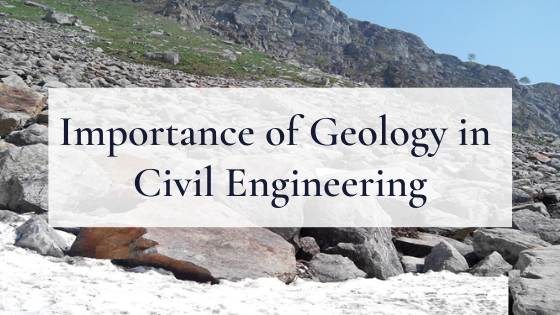The 8-Second Trick For Geotechnical Engineering For Construction Projects
Table of ContentsGeotechnical Engineering For Construction Projects for DummiesAbout Geotechnical Engineering For Construction ProjectsIndicators on Geotechnical Engineering For Construction Projects You Need To KnowOur Geotechnical Engineering For Construction Projects StatementsFacts About Geotechnical Engineering For Construction Projects RevealedThe 2-Minute Rule for Geotechnical Engineering For Construction Projects
The duty of geotechnical design dramatically handles realizing the functions of soil and rock, which may differ considerably by their thickness, moisture content etc. These features should be checked out by geotechnical designers to anticipate their activities under various circumstances. The safety and security along with stability of frameworks are influenced by soil conditions, making this analysis necessary.A geotechnical engineer will certainly take a look at soil to determine the bearing ability of the planet and advise appropriate foundation kinds, such as shallow structures, deep foundations like piles, or specialized remedies like floating structures for soft soils. Comprehending the attributes and actions of soil and rock, in addition to exactly how they communicate with buildings that have actually been set up on or within them, is among the main explanations for why geotechnical design is necessary.
Ecological defense is accomplished with geotechnical design. Knowledge in air, water, and dirt high quality maintenance is put to use by geotechnical engineers to decrease the unfavorable impacts of jobs.
Framework development, offshore engineering, tunnel building and construction, and deep structures. Risk-based design and multidisciplinary groups. These elements will certainly keep the area progressing and guarantee its ongoing importance in the years to come. To sum up, geotechnical engineering is an essential discipline that preserves the durability and stability of civil infrastructure. Geotechnical engineers contribute to making building projects efficient around the globe by recognizing the behaviour of planet products and using appropriate planning techniques.
Getting The Geotechnical Engineering For Construction Projects To Work
The fundamental stability of any kind of job is necessary. Geotechnical design plays an important role in ensuring that structures are developed on solid ground, essentially and figuratively. By analyzing dirt, rock, and subsurface conditions, geotechnical designers supply important understandings that assist in the layout, building, and upkeep of buildings and framework.

The Main Principles Of Geotechnical Engineering For Construction Projects
Laboratory screening: Figuring out the homes of soil and rock. A number of high-profile construction projects have actually successfully utilized geotechnical design to guarantee their security and security.

As a leader in geotechnical engineering, BECC Inc. is devoted to delivering innovative and reliable services that fulfill the greatest standards of high quality and safety., a mechanical designer and geologist.
Geotechnical Engineering For Construction Projects Fundamentals Explained
Terzaghi likewise created the structure for theories of bearing ability of structures, and the concept for prediction of the rate of settlement of clay layers as a result of combination. Later on, Maurice Biot fully developed the three-dimensional dirt consolidation theory, extending the one-dimensional design previously his comment is here established by Terzaghi to extra general hypotheses and introducing the collection of standard equations of Poroelasticity.
Geotechnical designers explore and determine the buildings of subsurface problems and products. They additionally make matching earthworks and maintaining structures, tunnels, and structure foundations, and might manage and review sites, which might better involve website surveillance along with the threat analysis and reduction of all-natural hazards - Geotechnical Engineering for Construction Projects. Geotechnical designers and design geologists carry out geotechnical investigations to acquire info on the physical residential properties of dirt and rock hidden and surrounding to a website to develop earthworks and foundations for suggested structures and for find out this here the repair service of distress to earthworks and structures brought on by subsurface conditions.
Things about Geotechnical Engineering For Construction Projects
, which makes use of a thick-walled split spoon sampler, is the most usual way to gather disturbed samples.

Generally, the interface's exact geometry is unknown, and a simplified user interface geometry is thought. Finite inclines need three-dimensional models to be analyzed, so most inclines are evaluated thinking that they are considerably broad and can be represented by two-dimensional designs.
The 5-Minute Rule for Geotechnical Engineering For Construction Projects
The empirical approach might be called follows: General exploration adequate to establish the harsh nature, pattern, and buildings of deposits. Evaluation of the most possible conditions and one of the most negative imaginable variances. Developing the design based upon a working hypothesis of behavior expected under one of the most possible conditions. Selection of amounts to be observed as construction proceeds and determining their prepared for values based upon the working hypothesis under one of the most unfavorable conditions.
Dimension of quantities and evaluation of actual conditions. Design adjustment per have a peek here real problems The empirical approach appropriates for construction that has already begun when an unexpected development happens or when a failure or accident looms or has actually currently occurred. It disagrees for jobs whose design can not be modified throughout building.